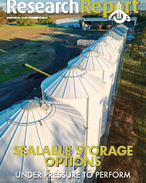This article is 3 years old. Images might not display.
For the sixteenth consecutive quarter, there were over one million head of cattle on feed. Meanwhile, 50 per cent of all cattle slaughtered in this quarter came from the feedlot, and 54.5 per cent of all Australian beef was grainfed, a new record for the industry.
These figures demonstrate that the feedlot sector has provided the supply chain with continued product, despite the rebuild limiting available slaughter cattle, MLA stated.
In the December quarter, national feedlot capacity and the number of cattle approved to be on feed, reached a new record of 1,453,580, with the approved yarding coming largely from New South Wales.
At the same time, utilisation, the number of cattle currently on feed as a percentage of capacity, rose three per cent for the quarter to reach 80 per cent. This simultaneous rise in capacity and utilisation means that new feedlot yards being built are being filled easily.
During the December 2021 quarter, 766,967 cattle entered the feedlot sector, demonstrating that despite high saleyard prices and tight supply, feedlots were able to source cattle.
The number of cattle on feed in Western Australia rose 40 per cent to 40,193 head. This is in line with historical seasonal trends, with more cattle in the state are sent to feed in summer and early autumn when feed availability drops.
The increased proportion of cattle being slaughter coming from feedlot led to a new male carcase weight record in most states. This was a result of record over-the-hooks (OTH) prices which averaged 723.04c/kg for the quarter, exceeding $7 for the first time, MLA reported.
Male carcase weights in Tasmania and Queensland exceeded 350kg/head at 352kg and 353.3kg respectively. Nationally male carcase weights were 343.1kg/head. WA, the state with traditionally the lightest cattle, was still recording weights over 300kg at 308kg, a 10kg jump for the quarter.
National female carcase weights were 279.7kg/head, not as high as the 280.6kg record in first quarter of 2021.
Key numbers highlighted in the December 2021 quarter Lot feeding brief, included:
- Quarter-on-quarter national cattle on feed hit 1,159,991 head, a 40,898 head increase for the quarter
- The number of cattle on feed in New South Wales increased by 28,608 head, or 9.5 per cent, to 330,977 head
- The number of cattle on feed in South Australia increased by 7769 head (21.4 per cent), to 44,096 head
- The number of cattle on feed in WA increased by 11,395 head (39.4 per cent), to 40,193 head
- Victoria recorded a decrease in cattle numbers on feed, with numbers dropping by 6008 head (9.8 per cent) to 55,326 head.
To read the December 2021 quarter Lot feeding brief, visit https://bit.ly/3hlRlGf























